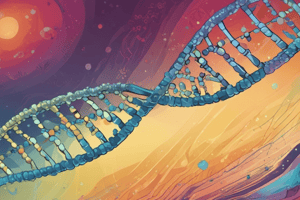Podcast
Questions and Answers
What is the limitation of the Maxam and Gilbert method in DNA sequencing?
What is the limitation of the Maxam and Gilbert method in DNA sequencing?
- The method can only sequence DNA fragments of up to 100 bases. (correct)
- The method is sensitive to temperature.
- The method requires a large amount of DNA sample.
- The method can only sequence a single DNA strand.
What is the primary function of piperidine in the Maxam and Gilbert method?
What is the primary function of piperidine in the Maxam and Gilbert method?
- To separate DNA fragments.
- To synthesize new DNA.
- To cleave the sugar–phosphate backbone at the modified bases. (correct)
- To modify individual DNA bases.
What is the purpose of adding dideoxynucleotides in the Sanger method?
What is the purpose of adding dideoxynucleotides in the Sanger method?
- To generate DNA fragments that end at a specific base. (correct)
- To modify individual DNA bases.
- To initiate DNA replication.
- To synthesize new DNA.
How many separate reactions are required in the Sanger method?
How many separate reactions are required in the Sanger method?
What is the role of the 3-hydroxyl group in DNA replication?
What is the role of the 3-hydroxyl group in DNA replication?
What is the chemical used to modify T residues in the Maxam and Gilbert method?
What is the chemical used to modify T residues in the Maxam and Gilbert method?
What is the purpose of radio-labelling one of the nucleotide triphosphates in the Sanger method?
What is the purpose of radio-labelling one of the nucleotide triphosphates in the Sanger method?
What is the purpose of using a DNA polymerase in the Sanger method?
What is the purpose of using a DNA polymerase in the Sanger method?
What is the primary advantage of the Sanger method over the Maxam and Gilbert method?
What is the primary advantage of the Sanger method over the Maxam and Gilbert method?
What is the limitation of the Maxam and Gilbert method in terms of the chemicals used?
What is the limitation of the Maxam and Gilbert method in terms of the chemicals used?
Study Notes
Structural Genomics
- Genetic and physical maps are used to determine the order of genes on a chromosome and their approximate distance apart.
- DNA sequence determination is performed using dideoxynucleotides that halt replication at a specific base.
- DNA fragments that differ by a single base can be separated using polyacrylamide gels.
- Sequencing reactions generate a few hundred bases of sequence.
- Whole genomes can be sequenced by cloning random small DNA genomic fragments, sequencing them, and then reassembling the genome sequence based on the overlap between the sequenced fragments.
- Massive computing power is required to assemble the sequenced fragments and determine the locations of genes within the genome.
Restriction Mapping
- Analysis of total genomic DNA and allocation or identification of restriction sites on genome using restriction enzymes.
- Restriction enzymes are used to digest the genome into fragments that can be processed for automated DNA sequencing.
- The resulting fragments can be fractionated on agarose gels to determine the restriction sites and gene orientation.
- Examples of restriction enzymes used include EcoRI and BamHI.
DNA Sequencing
- The process of determining the order of the nucleotides (A, T, G, C) in a genome.
- Types of DNA sequencing methods include:
- Dideoxynucleotide method
- Automated Sequencing
- Maxam and Gilbert method (Chemical cleavage)
- Sanger method (Enzymatic or Chain termination method)
Automated Sequencing
- The process uses dideoxynucleotides labeled with different acceptor dyes to terminate DNA synthesis.
- Sequencing reactions can be performed in a single tube and the products separated on a gel or using a capillary tube.
- The intensity and wavelength of the fluorescent emission are measured as the DNA fragments move past a laser Argon beam and fluorescence detector.
- This information is fed directly into a computer, assigning and storing the resulting sequence.
Maxam and Gilbert method (Chemical cleavage)
- A chemical method for cleaving the sugar–phosphate backbone of a radio-labelled DNA fragment at specific bases.
- Specific chemicals are used to modify individual DNA bases or sets of bases prior to cleavage of the sugar–phosphate backbone with piperidine at the modified bases.
- The separation of the cleaved products using high-resolution polyacrylamide gel electrophoresis allows assignment of individual bases within a DNA sequence.
Sanger method (Enzymatic or Chain termination method)
- An alternative sequencing approach based upon the faithful replication of DNA using a DNA polymerase.
- Dideoxynucleotides are incorporated into a newly replicated DNA chain to generate DNA fragments that ended at a specific base.
- The sequencing reaction is split into four separate parts, each with a mixture of the four nucleotide triphosphates and a single dideoxynucleotide triphosphate.
Studying That Suits You
Use AI to generate personalized quizzes and flashcards to suit your learning preferences.
Description
This quiz covers the basics of structural genomics, including genetic and physical maps, DNA sequence determination, and genome sequencing. Learn how to determine the order of genes on a chromosome and their approximate distance apart.




